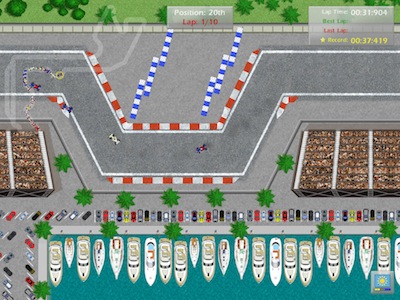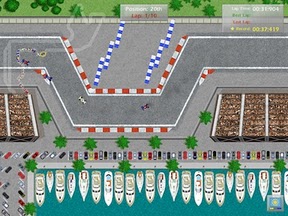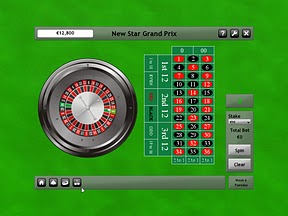This post has not been edited by the GamesBeat staff. Opinions by GamesBeat community writers do not necessarily reflect those of the staff.
My entry for the Fog of War Writing Challenge puts an unpublished piece I wrote last year under the microscope.
Original Version
A shareware 2D racing game — when was the last time you played one of those? When was the last time you even saw one of those? Regardless of the fact that it seems as though New Star Grand Prix is at least 15 years late, this game brings back fond memories of such classics as Micro Machines, Rock'n'Roll Racing, and Papyrus' NASCAR Racing series in the mid-90s (and to a lesser extent their IndyCar Racing series, which I only played a few times). The game itself plays like something of an amalgamation of all those older titles, except with a stronger emphasis on keeping it simple. Driving is as simple as holding down a key to accelerate, tapping another to brake, and steering with two others. You bounce off walls and other cars with little reduction in speed, and only an increase in the damage meter to deter such lapses in control. Keeping track of fuel levels and the condition of tyres is as simple as hitting the space bar, and you must be careful to visit the pits before either meter runs down to empty.

Where the game takes a turn away from traditional "casual" racing games, whilst also snubbing simulations in their focused approach, is in its off-track functions. You earn money from succeeding in races, as well as from sponsorship deals, but also from gambling at a casino, which you can visit with friends or the pit crew as a kind of bonding exercise. Doing this is important, too, as your relationship with each of the four groups in the game — your boss, the pit crew, the fans, and your friends — is given a star rating that goes up or down depending on your actions both on and off track. You can make your boss happy simply by getting good lap times in practice and qualification, as well as finishing in the points in the races themselves. The pit crew like you to get around the track in one piece during races and to spend time with them during the week, but they hate it when you damage the car. The fans just want you to win. And your friends want your attention and your gifts — you can buy cars and property for yourself or for your friends.

The game bases its tournament on the Formula 1 Championship/Grand Prix mechanism, using the traditional non-licensed approach of misspelled driver and team names, and vague names for locations (just the name of the host country) of each Grand Prix. A newspaper headline is presented at the end of each race to give an indication of your performance.
There is something special about New Star Grand Prix, but unfortunately the version I played only lets you play through the first three Grand Prix(s) of a season — too soon for me to figure out exactly where the magic lies. But it is clear that the game captures some element missing from contemporary racing games that makes me wish for a return to when I thought the racing genre was the coolest of the bunch.
Flesch Reading Ease: 58.56
Flesh-Kincaid Grade Level: 12.00
Gunning fog index: 15.29
See page 2 for the edited version and reflections
Edited version
 A shareware 2D racing game — when was the last time you played one of those? When was the last time you even saw one of those? New Star Grand Prix brings back fond memories of such classics as Micro Machines, Rock'n'Roll Racing, and Papyrus' NASCAR Racing series. The game itself plays like something of an amalgamation of all those older titles, except with a stronger emphasis on keeping it simple. Driving is done by holding down a key to accelerate, tapping another to brake, and steering with two others. You bounce off walls and other cars with minimal loss in speed, but damage your car in every collision. Keeping track of fuel levels and the condition of tires requires that you periodically tap the space bar, and you must be careful to visit the pits before either meter runs down to empty.
A shareware 2D racing game — when was the last time you played one of those? When was the last time you even saw one of those? New Star Grand Prix brings back fond memories of such classics as Micro Machines, Rock'n'Roll Racing, and Papyrus' NASCAR Racing series. The game itself plays like something of an amalgamation of all those older titles, except with a stronger emphasis on keeping it simple. Driving is done by holding down a key to accelerate, tapping another to brake, and steering with two others. You bounce off walls and other cars with minimal loss in speed, but damage your car in every collision. Keeping track of fuel levels and the condition of tires requires that you periodically tap the space bar, and you must be careful to visit the pits before either meter runs down to empty.
 New Star Grand Prix takes a turn away from traditional "casual" racing games — and snubs the focused approach of simulations — in its off-track functions. You earn money from winning races, as well as from sponsorship deals, which are more lucrative for successful drivers. You can spend time at the casino, trying to double your fortune. Your relationship with each of the four groups in the game — your boss, the pit crew, the fans, and your friends — is given a star rating that goes up or down depending on your actions both on and off track. You can make your boss happy simply by getting good lap times in practice and qualification, as well as finishing in the top six in the races themselves. The pit crew like you to get around the track in one piece and to spend time with them during the week, but they hate it when you damage the car. The fans just want you to win. And your friends want your attention and your gifts — such as cars or houses. Both friends and the pit crew also enjoy trips to the casino.
New Star Grand Prix takes a turn away from traditional "casual" racing games — and snubs the focused approach of simulations — in its off-track functions. You earn money from winning races, as well as from sponsorship deals, which are more lucrative for successful drivers. You can spend time at the casino, trying to double your fortune. Your relationship with each of the four groups in the game — your boss, the pit crew, the fans, and your friends — is given a star rating that goes up or down depending on your actions both on and off track. You can make your boss happy simply by getting good lap times in practice and qualification, as well as finishing in the top six in the races themselves. The pit crew like you to get around the track in one piece and to spend time with them during the week, but they hate it when you damage the car. The fans just want you to win. And your friends want your attention and your gifts — such as cars or houses. Both friends and the pit crew also enjoy trips to the casino.
The game bases its tournament on the Formula 1 Championship, using the standard non-licensed approach of misspelling driver and team names, with vague names for locations (just the name of the host country) of each Grand Prix. Your performance is indicated by a newspaper headline at the end of each race.
There is something special about New Star Grand Prix, but unfortunately the version I played only lets you play through the first three races of a season — too soon for me to figure out exactly where the magic lies. But it is clear that the game captures some element missing from contemporary racing games that makes me wish for a return to when I thought the racing genre was the coolest of the bunch.
Flesch Reading Ease: 63.24
Flesh-Kincaid Grade Level: 10.00
Gunning fog index: 10.44
Reflections
I originally wrote this piece in April last year. I always thought it was one of my better unpublished works, so I decided to put it to the test.
It wasn’t particularly hard to improve the scores — the original piece had several excessively long sentences, and was quite wordy in a few places. By simply cutting the baggage and removing passive voice, most of the work was done. I cleaned up a few other minor problems, changed to American spelling, then decided to call it a day.
There are further improvements I could make with really focused editing (or a total rewrite), but I’m happy to settle for what I’ve got.
I didn’t learn much from the exercise apart from the fact that I’ve improved considerably as a writer in the past year. That, together with the editing practice, is enough to make it worthwhile, though.
